|
1.
CENTRAL/ WEST AFRICA
Trade continues to be low during start of year
West African prices have not changed from those reported
at end January. Trade volumes have been low as has
production, and exporters have been concentrating on
matching particular species to specific demand rather than
offering a normal mix of species and sizes. There have
been pockets of demand, with Vietnam looking for tali and
buyers from China interested in tali, okan and padouk
logs. India was asking for two of their favorites, padouk
and belli in logs and lumber. Apart from such specialities,
demand from Asian markets has been low. Observers
estimate around 50% of production capacity in Gabon,
Cameroon and Congo Brazzaville has shut down and
producers have been requesting temporary relief from
governments on the various forest and export taxes.
Governments have been finding it difficult to agree as
income from forest and export taxes have already been
severely hit by various mill and concession closures.
European markets have been very quiet; demand has been
low even for favored species and as noted in our last report
(TTMR 14:2) the ban on harvesting of four species in
Gabon has not stimulated any sudden rush to mop up the
very limited stocks remaining in the hands of producers,
possibly because importers have already been holding
more than adequate stocks. One exporter reports a buyer
would agree to place a contract for moabi only if credit has
extended for three months. Italy in particular has been
very quiet, with normal demand for ayous and okoume
having fallen away. The producers¡¯ overlying sapele
stocks have been slowly absorbed and due to low or no
production in Northern Congo and Central African
Republic, it is likely sapele lumber prices will during the
second quarter finally become more stable. Sipo firmed up
marginally during January and has held on to the higher
price. Exporters that still have some reasonable production
capacity have been concentrating on supply of a very
limited range of species in logs and lumber to Asian
markets.
There have been no predictions of how the market in
China will be affected due to the present global economic
downturn, although there have been some indications
Chinese demand for African sawn timber in the mediumterm
will increase in proportion to total demand for sawn
lumber. Demand for Vietnam is expected to continue on
an upward trend. Sawmills report much difficulty in
finding orders sufficient to keep mills running
economically.
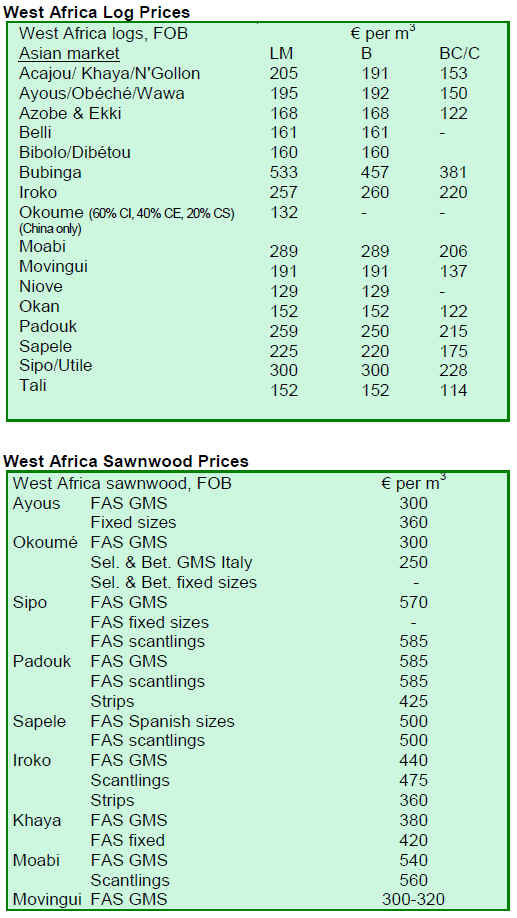
2. GHANA
Little movement in Ghana¡¯s prices
Prices for most of Ghana¡¯s species remained unchanged
during the last fortnight. Asanfina was the only species
increasing in price for logs. This lack of movement in the
market was attributed by local experts to the effects of the
global economic slowdown, which negatively impacted
timber and wood product exports to European and US
markets. Since trading has been slow, Ghana¡¯s Timber
Industry Development Division (TIDD) has not reviewed
the Guiding Selling Prices (GSP) of timber and wood
products for the first quarter of 2009. Experts are eagerly
awaiting the first budget of the new government, which is
expected to be released in March 2009. The budget is
widely anticipated to reduce certain taxes on petroleum
products, a key promise made during the recent elections
campaigns, and affect a wide range of Ghana¡¯s goods and
services.
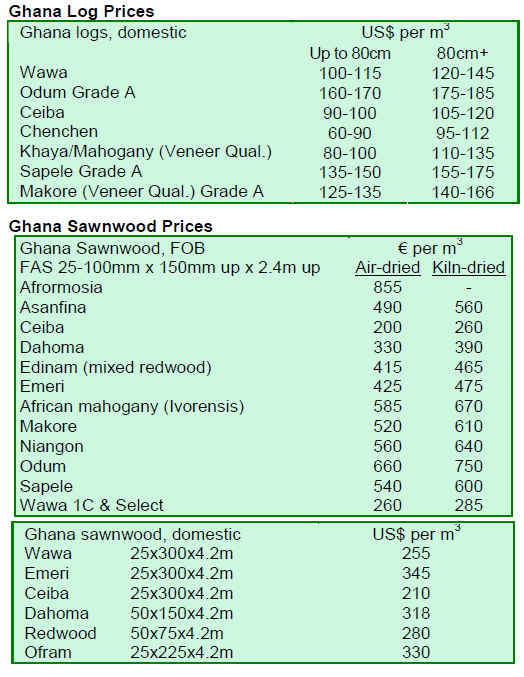
3.
MALAYSIA
Malaysia to launch new National Wood Industry Policy
Deputy Prime Minister Datuk Seri Najib Tun Razak plans
to launch a new National Wood Industry Policy (NATIP)
later this month, which is expected to shift the timber
industry¡¯s structure. The announcement came from the
Plantation Industries and Commodities Minister Datuk
Peter Chin Fah Kui, who said the new policy needed to
address both upstream and downstream industries as well
as exports. With changes under the new policy, officials
from Malaysia hope to generate exports worth RMB53
billion by 2020, with 60% of this amount to be generated
from downstream activities and 40% from upstream
activities. Chin said the new policy is aimed at decreasing
waste and increasing the amount of value-added products
for export. The government is also expected to create
programmes to showcase local furniture, which would
stimulate greater participation in the forest plantation
scheme established in 2006. Nevertheless, Chin expressed
concern over the falling prices for primary timber products
such as sawn logs, fiberboard, and plywood and prospects
for the market in 2009.
Malaysian furniture producers urged to sharpen competitiveness
The Ministry of International Trade and Industry (MITI)
called on furniture manufacturers to sharpen their focus
and marketing strategies to broaden their engagement with
underdeveloped markets such as the Middle East, India,
Russia and the countries of the Commonwealth of the
Independent States (CIS), reported Bernama News. Faced
with challenges on several fronts in the marketplace such
as the weakening Malaysian ringgit against other major
currencies, a rapidly declining international export market
and shortage of trade financing within Malaysia, MITI will
organize Malaysian furniture exhibitions to promote the
country¡¯s brands at international trade shows. These
include I-Saloni in Milan this April.
Although the furniture industry only grew 1.7% during the
first 10 months of 2008 to RM8.37 billion, MITI officials
are optimistic the Malaysian furniture industry will grow
2% to 7% in 2009. China¡¯s decreasing competition in the
marketplace has helped Malaysia¡¯s wood products gain a
competitive edge in the markets, said MITI. However,
trade analysts have dismissed the projections as overly
optimistic as global financial trade continues to bottom out
in light of the financial crisis.
New EU rules on pesticides for timber products
Exports of raw timber products to the EU, including
sawnwood and logs, will be subjected to a new regulation
on pesticides residues used in agricultural production,
reported Bernama News. The European Parliament
approved the regulation, which will take effect in 2009,
with the view to ensure increasing stringency on the use of
pesticides on EU imports. Under the new regulation,
pesticide residues must not exceed the general default
maximum residue level (MRL) of 0.01mg/kg.
Prices slide amid worsening economic situation
Prices of Malaysian timber products, particularly
sawnwood, continued to decline in the international
market. Saw mills have been pondering the next course of
action, since excessive sawnwood stocks continue to pile
up in sawmill yards across the country. Nevertheless,
timber traders were attempting to resist further price
erosion for their products, as most of them are already
operating at a loss.
With the first national economic stimulus plan failing to
register any improvement in the economy, the number of
housing construction project failures is expected to rise
dramatically, resulting in abandoned projects. This may in
turn negatively affect the local banking industry as most
banks have high exposure to the construction industry in
their lending portfolios.
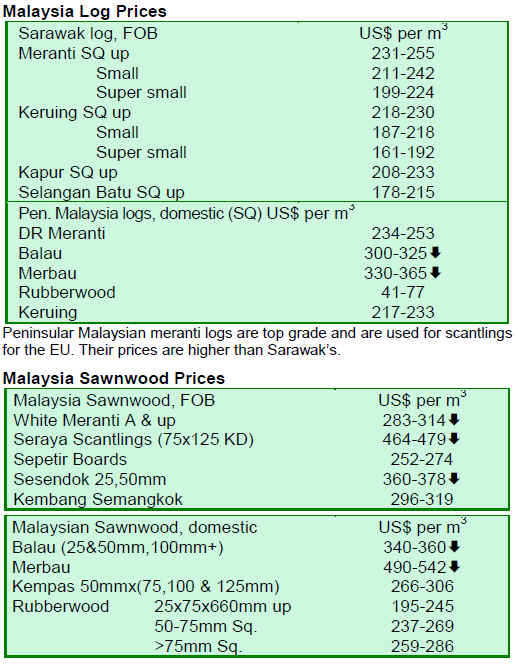
4.
INDONESIA
Indonesia mulls export of plantation logs
Antara News reported on the Ministry of Forestry¡¯s
proposal to open exports of logs from timber plantations.
The move would address the disparity in price between
logs sold to the pulp and paper industry and those
available in the international timber market. If the measure
is approved, logs offered from Indonesia would be more
competitive with those from neighboring Sarawak.
Although two pulp and paper giants, Asia Pulp&Paper and
Riau Andalan Pulp and Paper (Riaupulp) consume 85% of
logs produced from timber plantations, prices offered by
the two companies have not generated enough profit for
the plantation forest industry to contribute to its
development. President Director Mustoha of the stateowned
forestry company PT Inhutani IV commented that
log prices, set at a range from Rp220,000 to 230,000 per
m³ were too low, and price fixes were needed to expand
Indonesia¡¯s export market and counter the decline in
domestic demand for timber.
Regional administrations seek approval for local forest conversions
A number of local administrations have been submitting
applications to the Indonesian Ministry of Forestry to
convert their natural forests into forest plantations,
reported The Jakarta Post. Central government officials
noted they were struggling to comply with laws for
forestry and spatial planning while attempting to meet
demands from local governments.
The Director of the National Development Planning
Board, Basah Hernowo, expressed concern over the
uncertainty associated with the spatial planning law, as the
2008 spatial planning law allows local administrations to
revise the regulations after five years; this could cause
further deforestation and damage to the environment.
Moreover, the Indonesian Association of Forestry
Concessionaires (APHI) expressed reservation over the
future of Indonesia¡¯s forests. Indonesia¡¯s reported
deforestation rate between 1987 and 1997 was 1.8 million
ha per year, climbing rapidly to 2.8 million ha per year
from 1998 to 2000, before returning to about 1.8 million
ha per year from 2000 to 2006.
Perhutani supports lifting teak export ban
Forestry Minister M.S. Kaban said the government could
lift a ban on teak exports from industrial forests, since the
government is expecting a decline in demand from the
domestic market in the midst of the global economic
crisis.
State-owned company PT Perhutani said it would support
such a plan if approved. According to Upiek Rosalina
Wasrin, chief executive of Perhutani, about 90,000 m³ to
100,000 m³ of teak logs would be available for export in
2009. The company produced 300,000 m³ of teak in 2008,
although the local furniture industry could only absorb up
to 15,000 m³ of teak logs, an amount which could decline
in light of the ongoing global economic turmoil.
Elfian Effendi, Executive Director of the non-profit
Greenomics, said the ban should be lifted only on exports
to Japan, but only if Japan agreed to forgive Indonesia¡¯s
foreign debt. Elfian noted that more than 70% of
Indonesia¡¯s foreign debt is with Japan.
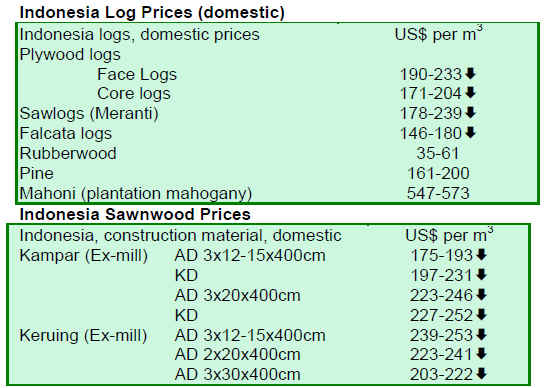
5.
MYANMAR
MTE changes sales of teak from FOB to Ex-works
The Myanmar Timber Enterprise (MTE) issued a notice
on 6 February 2009 indicating all direct sales of timber
would be made on an Ex-works basis in lieu of the usual
FOB basis. However, the exception to this rule is where
the MTE will continue to act as the shipper. This decision
has been taken after an incident occurred on the Rangoon
River involving an MTE container that was reportedly
shipped by MTE on behalf of a private company (see story
below).
As a result of the decision, all sawn timber, secondary
processed wood products and logs from direct sales will be
made on an Ex-works (sawmill, factory or deposit) basis.
This will be applicable to all contracts including those
already issued. Exception will be made for some
shipments for which export documentation has been
processed and an export license issued. In general, the
tender quantity is very small, at about 1,000 tons per
month, although direct sales volumes are huge.
Heroin seized in Rangoon port
On 25 January 2009, police in Myanmar seized more than
89 kilograms of heroin packed in a container ship bound
for Singapore, reported the AFP. The ship, Kota Tegap,
was Singaporean flagged and left from Rangoon¡¯s Asia
World Port Terminal, reportedly owned by a ¡®family of
notorious drug traffickers¡¯. The container was owned by
the Myanmar Timber Enterprise, which has been subject
to US sanctions since last year. The Rangoon police
indicated the container was not inspected before leaving
the port in Rangoon and was seized on the Rangoon River.
A Special Police Force was questioning various
government officials and businessmen in light of the
recent drug seizure. Myanmar follows Afghanistan as the
world¡¯s largest producer of opium, which is used to
produce heroin.
No price changes for Myanmar logs
As shown below, there have been no changes to prices
during the previous fortnight. The next tender sales are
scheduled for 22 February 2009.
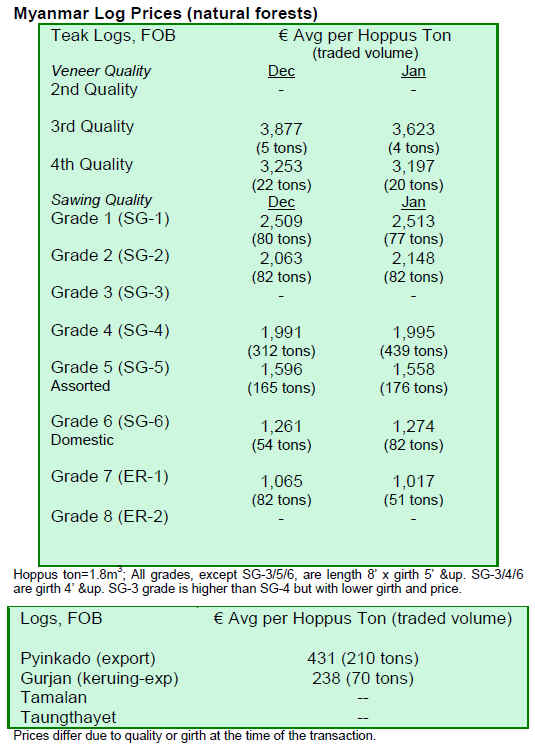
6. BRAZIL
Brazilian forest sector sees falling exports
Folha da Mata Online reported that forest products
exported from the State of Par¨¢ dropped by volume and
value in 2008 compared to 2007 levels, according to a
statement made by the Timber Exporting Companies
Association of Par¨¢ (AIMEX). Exports were USD631
million in 2008, a decrease by value of 20.4% compared to
the previous year. Exported timber fell 35.8% by volume,
a larger drop than by value. Among the products showing
the largest decrease by volume in 2008 were: sawnwood
(-41.8%); veneer (-54%); flooring (-24.5%); and plywood
(-41.4%). The drop in exports of industrialized and
manufactured timber products from Par¨¢ was attributed to
the delay in approval of forest management and
reforestation projects and unfavorable exchange rates,
which undermined the performance of the timber sector.
At the end of 2007, Par¨¢¡¯s exports decreased due to the US
subprime mortgage crisis, since the US civil construction
sector accounted for one-third of timber exported from
Par¨¢. By the end of June 2008, exports had dropped 8.98%
by value and 28.19% by volume compared to the same
period of 2007. Despite the crisis, other countries
continued buying timber until the third quarter of 2008. As
a result, price increases in the third quarter compensated
losses from the falling US dollar. Once the general
economic crisis began in late October 2008, there was a
significant reduction in the purchase of industrial and
manufactured timber products, which lowered results for
the state of Par¨¢ in 2008.
Sao Bento furniture cluster holds optimistic outlook for 2009
After three years of a continuous slump in sales and job
generation, furniture companies of the Sao Bento do Sul
cluster in the Southern state of Santa Catarina reportedly
held high hopes for recovery in 2009. The reason, reported
Di¨¢rio Catarinese/Centro Gestor de Inovação Moveleiro,
was that April has historically been a refurnishing period
in the US and Europe, the main international markets for
Brazilian furniture. Companies hope demand will increase
again around this time in 2009.
According to the Sao Bento do Sul Trade Association
(ACISBS), the furniture sector once accounted for 40% of
the local economy. However, the sector currently accounts
for only 22%, partially due to the ongoing crisis in the
forest sector, along with the growth of other sectors such
as the metal, mechanics, textile, cleaning products and
services industries. As an initiative for the sector¡¯s
improvement, the Bento Gonçalves Furniture Industry
Association (Sindm¨®veis) has been implementing
activities to promote Brazilian furniture abroad. Aware of
the need to make the industry more global, the Association
has set an agenda to promote business in other countries in
2009. In 2007, sales abroad only reached BRL1 billion of
the total BRL21.3 billion in revenue for the sector - less
than 5% of sales of the furniture industry in Brazil.
Alta Floresta wood exports plunged 34% in 2008
S¨® Not¨ªcias reported on the municipality of Alta Floresta¡¯s
wood products statistics in 2008, noting it was one of the
major timber producers in the Brazilian Amazon. Alta
Floresta closed 2008 with 32.1% drop in wood product
exports. According to the Ministry of Development,
Industry and Foreign Trade, exports of various timber
products from January to December 2008 reached
USD14.2 million, compared to the USD20.9 million
recorded in 2007. Exports of timber products faced
substantial reductions in trade, including of non-coniferous
parts (-22.9%), which were worth USD11.8 million.
Exports of sawnwood cut into sheets (thicker than six
millimeters) were USD1.9 million, 52.6% lower than in
2007, when total exports reached USD2.9 million. On the
other hand, exports of some items such as Ipe parts
(116%) increased in 2008 from 2007. The largest share of
exports in 2008 went to the US (USD7.5 million),
although overall sales dropped 28.5% from 2007 levels.
Alta Floresta exported USD2.2 million to Spain in 2008, a
fall of 29.8% compared to 2007. The exception to the
slump in exports was Israel, which registered imports of
USD1 million, a 28.8% jump from 2007 levels.
Buyers cancel export orders of Brazilian timber
The global economic crisis has continued to affect timber
exports from Brazil, reported Folha de São Paulo.
According to the Timber Producers and Exporters
Association (ABPMEX), Brazilian timber producers have
already reported a 40% cancellation of export orders. If
the external demand for products continues to decrease,
the expectation is that timber exports will be reduced by
15-20% in 2009. Foreign importing companies have
cancelled orders with already approved credit letters. This
situation has never before occurred in Brazil. Even with
approved credit, importers are not making purchases
because domestic buyers would not be able to consume
them.
According to the ABPMEX, 15% of Brazilian solidwood
production is exported, with 60% being sent to the US. In
2008, total timber exports reached USD2.7 billion, 17.3%
less than in 2007. With the fall of external demand,
entrepreneurs have attempted to redirect their products to
the domestic market. Some items, however, are made
specifically for foreign markets and do not have buyers in
the domestic market. This is the case, for instance, of
wooden fences manufactured for American houses. Thus,
the domestic market cannot absorb all production. Instead,
part of the solution will involve reducing production and
extension of holiday vacations.
Layoffs in the timber industry may eventually happen, but
so far this has not occurred at a significant level. The
timber sector has already been facing problems before the
economic crisis. In the first half of 2008, the sector already
experienced a decline in exports due to the depreciation of
the US dollar. When the Brazilian real depreciated against
the US dollar because of the economic crisis in the second
half of 2008, sales in the domestic market further
deteriorated.
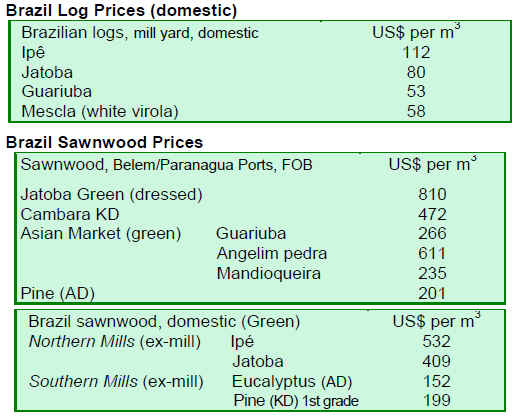
7.
PERU
EU to negotiate FTA with Peru, Ecuador and Colombia
The Peruvian Times and Andina reported that Peru,
Ecuador and Colombia have been undertaking
negotiations on a Free Trade Agreement (FTA) with the
EU. The first meeting for the negotiations was held in
early February and the countries hope to conclude their
discussions by mid-2009. The negotiations were initially
postponed due to Bolivia¡¯s refusal to engage in the talks
and threats to veto bilateral negotiations. Despite this
setback, the discussions with Peru, Ecuador and Colombia
are due to continue and address issues such as market
access, trade facilitation and sustainable development.
Peru targets 900,000 ha of certified forests in 2009
Jos¨¦ Camino, Chief of the National Institute of Natural
Resources (INRENA), expects Peru will certify or recertify
900,000 ha of forests by the end of this year.
Camino noted Peru ranked third after Brazil and Bolivia
for having the largest area of certified forests in Latin
America. He said Peru¡¯s goal was to certify about 2
million ha of forests. The areas currently containing the
most certified forests in Peru are Huanuco, Madre de Dios,
Ucayali, Loreto and Pasco.

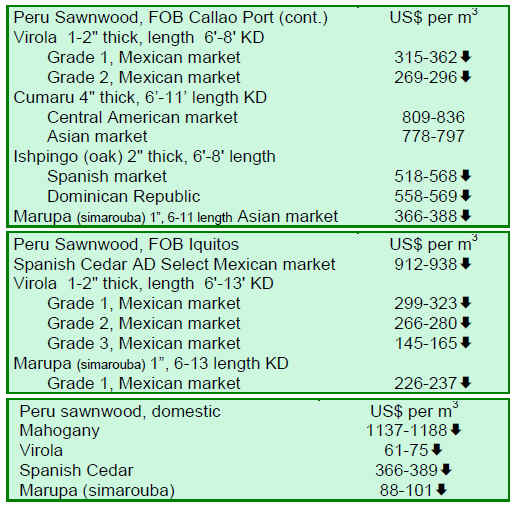
8. BOLIVIA
Bolivia passes new constitution recognizing
indigenous rights
According to the BBC, a new constitution was enacted by
President Evo Morales, which strengthens rights for
country¡¯s indigenous people. Morales, saying Bolivia had
been ¡®refounded¡¯ as a result of the new constitution, is the
country¡¯s first indigenous president. The new constitution
will grant rights to Bolivia¡¯s 36 indigenous groups on
numerous issues, including setting new limits on
ownership of land to 5,000 ha, although the measure is not
retroactive. Despite this perceived victory for Morales,
opposition to Morales still lingers in the country¡¯s eastern
lowlands.

9. Mexico
Community forest programme receives further funding
The National Forest Agency (CONAFOR) received a new
loan from the World Bank in the amount of USD100
million to implement its Programme of Communitarian
Forest Development (Procymaf) through year 2010. The
programme focuses on the management of natural
resources of common lands and forest communities,
giving particular attention to local development. In 2010,
actions to address the mitigation and adaptation of climate
change are included in the programme, as well as
establishment of commercial forest plantations and the
extension of proposals to increase productive capacities of
marginalized groups.
10.
Guyana
Log exports off to slow start in 2009
Log exports for the year are off to a slow start owing to the
low volumes of harvest in the month of December and the
higher demand for Guyana¡¯s sawnwood. Only 43 m³ of
logs were exported in the second fortnight of 2009, mainly
consisting of standard sawmill quality purpleheart heading
to destinations in India. Nevertheless, log prices jumped
by 52% compared to January 2008 average prices. Log
exports in January 2008 were 8,929 m³, which highlights
the significant drop in this year¡¯s log exports compared
with the corresponding period last year. The export
markets targeted show a similar trend to that which
prevailed in 2008, when the total volume of logs exported
was mostly consumed in the Asian/Pacific region and
accounting for the majority of volume and value totals. In
this region, the two main destinations for Guyana¡¯s logs in
2008 were China and India. China consumed 45% of all
logs exported while India consumed 42%.
For added value products, shingles showed strong results
in 2009 with an 81% increase in value over January 2008.
The overall price level has also jumped by 60%.
Similarly, the export of other value-added products
including doors has increased substantially over the
January 2008 levels. The highest revenue earner for
January 2009 was Dressed Lumber, accounting for 42% of
total export value. Shingles were the second largest
revenue earner for the month.
Lending to forest sector on the rise
According to reports from the Central Bank of Guyana,
loans and advances to business enterprises in the forest
sector have shown considerable increases in 2008
compared to same period of 2007 (January to November).
A robust 38.9% increase in investment recorded in the
sector reflects a continued interest in Guyana¡¯s timber
products of Guyana, both locally and internationally.
Guyana establishes REDD Secretariat
As part of its REDD preparedness activities, the GFC
received support from Conservation International (CI)
Guyana in January 2009 for the establishment of a
Reducing Emissions from Deforestation and Degradation
(REDD) Secretariat. The Secretariat will be tasked with
coordination of relevant activities to link key institutions
and stakeholder groups in the implementation of activities
and dialogue on REDD.
It is hoped the Secretariat will create a formal structure
and framework for REDD activity implementation through
the development of a methodology to conduct a national
assessment and create a forest carbon stock monitoring
system that are appropriate, applicable, feasible and
relevant to the Guyana context. Activities are also
expected to generate a continuous updated information
base on forest carbon storage capacities and serve as the
basis for securing global carbon financing mechanisms,
performance based payments and positive incentives.
One of the first activities of the REDD Secretariat,
working in collaboration with the Guyana Forestry
Commission, will be to conduct a nationwide sensitization
and consultation programme on climate change and
REDD. Several teams were dispatched to various regions
in the country with the purpose of engaging forest-based
communities and other stakeholders.
A total of 27 outreach sessions were made, with
participation from over 35 community groups, including a
number of indigenous communities. Additionally, through
continuing work of this kind, an integral link will be
established to encourage sustainable development and
improve livelihoods for local communities including
indigenous populations - all within the wider context of
sustainable forest management (SFM).
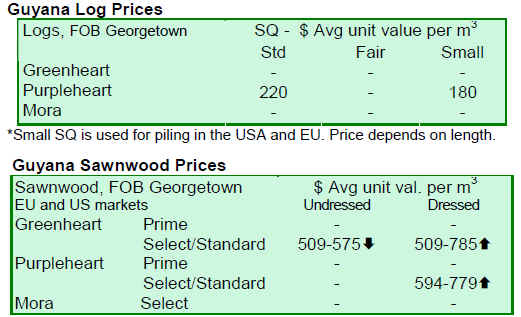
|